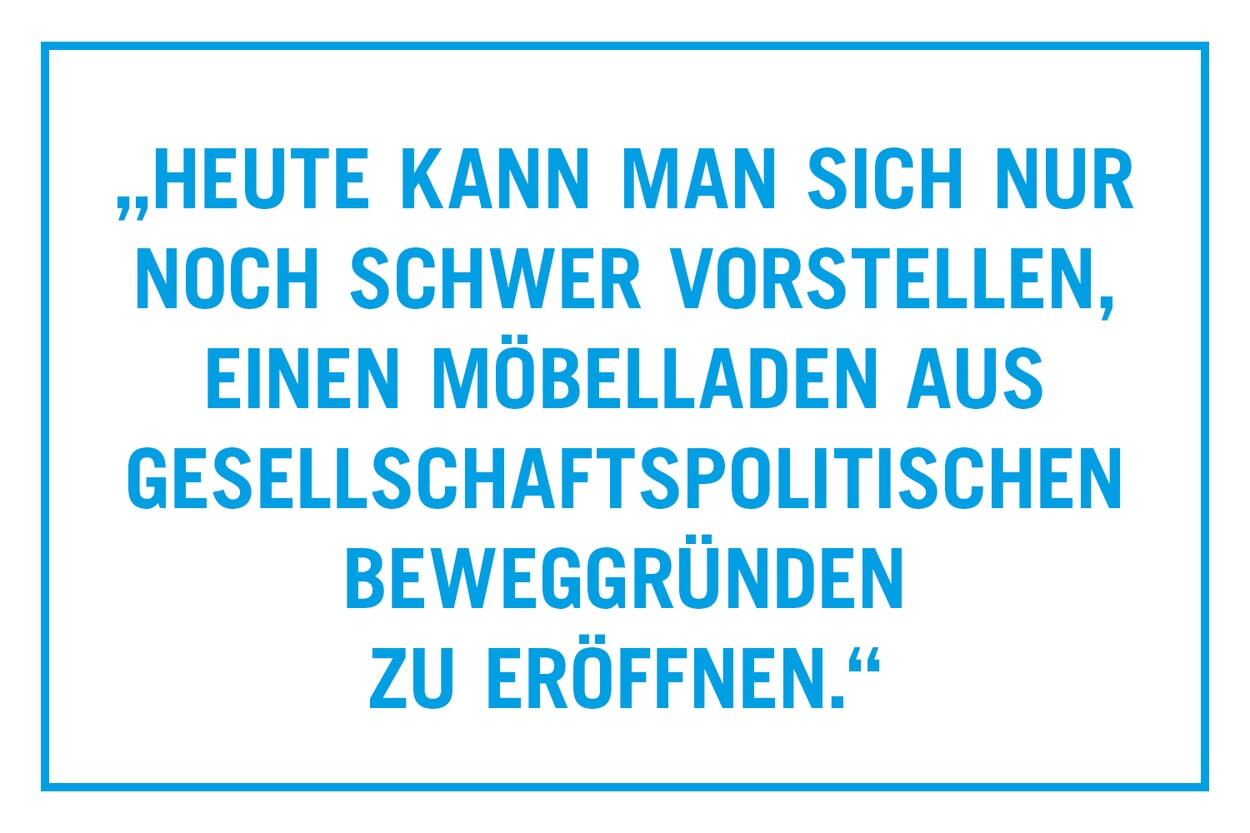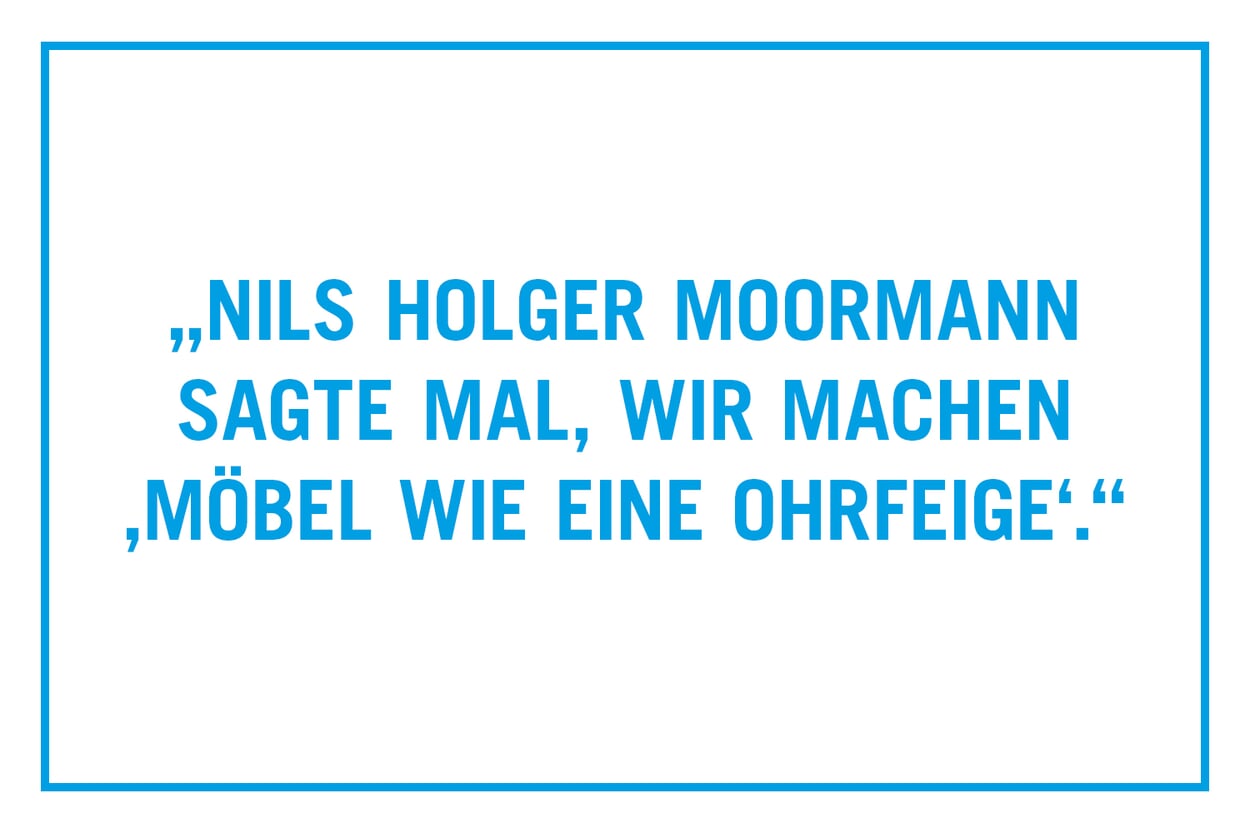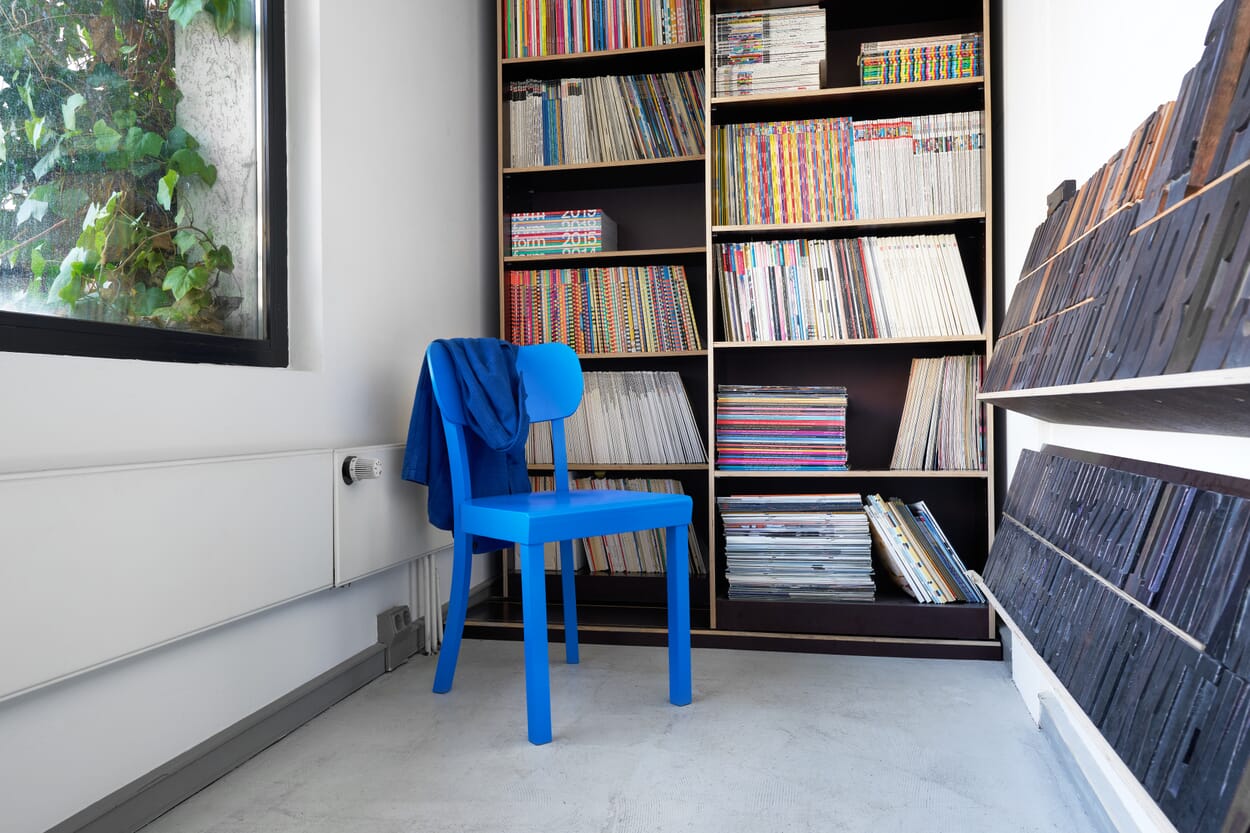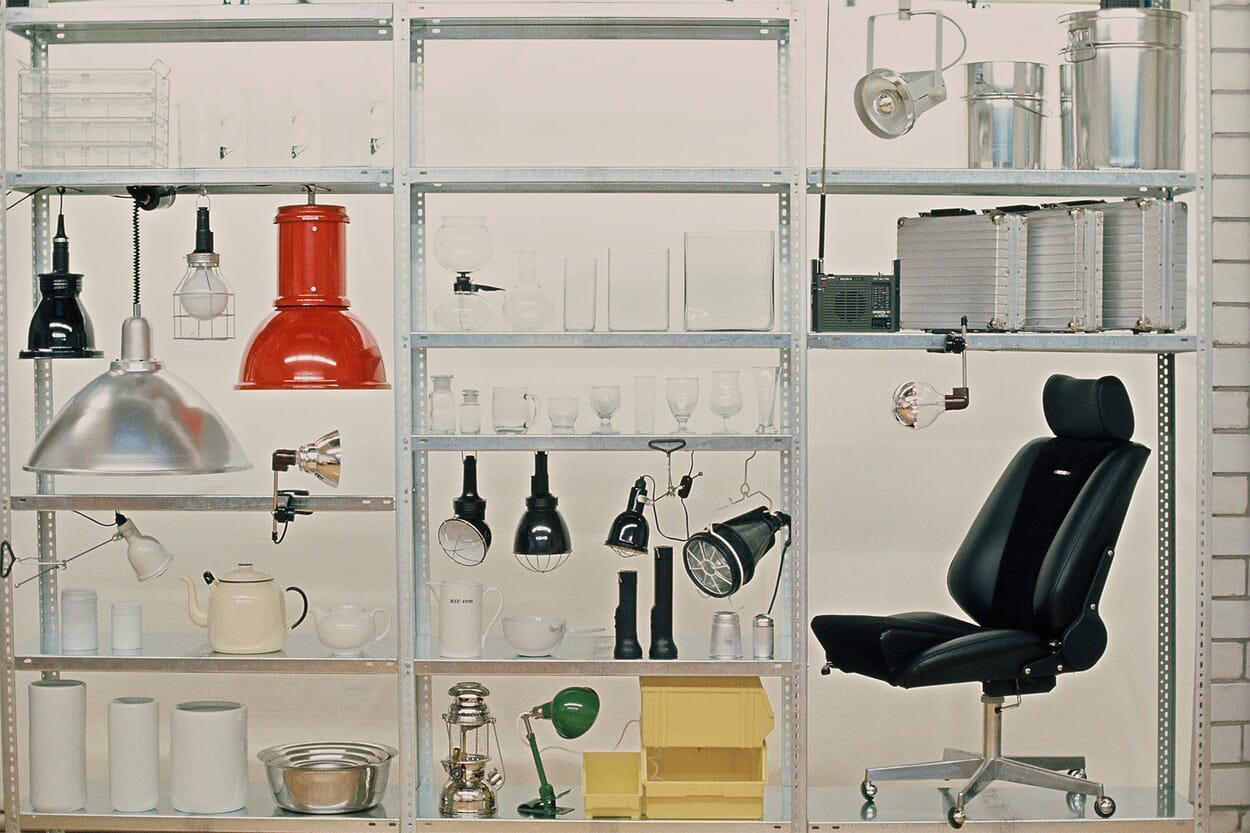DESIGN STORY(IES)
"DRILLING THE THICK BOARDS IS MUCH NICER THAN THE PLYWOOD!"
A conversation between Stephan Dornhofer (Managing Director MAGAZIN) and Markus Frenzl (design critic, author and professor of design theory at Munich University of Applied Sciences)
Markus Frenzl: You started your training in a Scandinavian furniture store in the mid-seventies. What was special about MAGAZIN when you first came into contact with it? Stephan Dornhofer: As a young person with an obvious interest in graphics and design, I started there and was immediately fascinated by the things: stacks of Arne Jacobsen chairs, things I didn't know from home - I quickly became addicted to design. In conversations with the traveling salesmen, there was always talk of this "Stuttgart store", MAGAZIN. When I visited MAGAZIN in Stuttgart for the first time at the end of the seventies, there was a great sense of friendliness and openness. When we later came up with our own MAGAZIN idea, the founders were very happy, were very enthusiastic about their store idea and supported us as a matter of course MF: Today it would be a franchise concept! So there were no negotiations about usage rights or licenses? Did the founders earn nothing from this? SD: No, nothing at all. There were no reservations about taking over their own logo, name and business model. That was sensational and incredibly generous. But it also shows their genuine interest in getting a message out into the world. Because of course there was this sense of mission. - When was your first contact with MAGAZIN? MF: In the late eighties on a school trip to Stuttgart. I bought a pair of red scissors and a Japanese pen, I remember that very well, at horrendous prices for me as a schoolboy. But for me, the store was above all the realization that design is not just about postmodernism and "matte black", but can also mean the transfer of things from other contexts. There were the objects that you found in the basement on the industrial shelves: simple pressed glass, objects from industrial supplies, unpretentious but good, durable things. SD: MAGAZIN was a great expansion of their aesthetic field for many. For many Stuttgart students of architecture and design - and also far beyond the regional borders - it was part of their cultural education. The experience of knocking sacred things off their pedestals. The experience you had with the red scissors and the Japanese pen. It wasn't design with a gold rim, but an extension of everyday culture. It was common to go to MAGAZIN on Saturdays to stock up on good products, just like at the weekly market. Incidentally, this can still be seen in our stores today.
MF: Modernism had opened up possibilities for differentiation that no longer had much to do with the original ideals of improving the living conditions of the masses. So MAGAZIN must also be seen against the backdrop of the critique of functionalism and the return to modernist ideals. Today, it's hard to imagine opening a furniture store for socio-political reasons. SD: The founders were part of the 1968 movement; they were concerned with the state of society, which was resinous and dusty. There was a completely different product world. In addition, there was a procurement problem that is unimaginable today. And social development was much more about individuality: how can I design the space according to my needs, illuminate it well, organize things well? But the idea was to break up the rigidity and rethink MF: How much did the founders question their own commercial success? In terms of social impact, they should have consistently offered more DIY workshops instead of just selling products. My Offenbach design theory professor Jochen Gros developed instructions with the Des-In group in the 1970s on how to furnish yourself without industrial production, how to build a sofa out of old tires or lamps out of cliché sheets. It was all about self-empowerment and new distribution and production structures.
SD: Of course, this was also reflected and could be seen in the product world. But MAGAZIN was not a consumer advisory service, with all the sense and joy of product-related information, but rather focused early on the mercantile in order to have a social impact. MF: Are these motives still valid today? Shouldn't the focus now be much more on new cultural patterns rather than always on new products? For example, not reacting to the waste problem of coffee-to-go cups with reusable cups that you then sell in stores, but instead recharging the coffee house culture? I often miss these considerations when thinking about sustainability or circular design, which have often become buzzwords for marketing. - As a retailer, you naturally want to sell. But with your standards of choice, sustainability, longevity and conscious consumption, it can't be your goal for everyone to buy six new chairs a year. How do you deal with this discrepancy? SD: By talking about it openly: no product is sustainable! Of course, as retailers we are in a dilemma. We want to sell products. But our aim is to make these products as good as possible. So that they fit into our times, that they meet ecological requirements, that they are designed with current social issues in mind. We try to make our contribution to this and, on this occasion, we stand shoulder to shoulder with our shareholder Manufactum. We therefore see ourselves as having a responsibility that is critical of consumption. We want to make sustainability a matter of course and not turn it into a marketing bubble, as is now widespread. We look at the interrelationships and try to keep the impact as low as possible.
MF: Design is always also cultural production. Do you see yourselves as a company that shapes society and creates culture? SD: The critical look at what our industry throws onto the market year after year - in a way: throws out - leads us to an assortment that is no longer a matter of course for companies. We really ask ourselves what we can leave out. We can implement this consistently in our own products: We think about resource-saving use of materials, durability or sensible packaging. We think about demand. We fundamentally question the product typology: are there sensible closets that are something other than wallpapered chipboard? Which ecological materials can be used that can be assembled and disassembled without the threads falling out? Are you saying: "This product would probably sell well, but it doesn't fit in with our ideals, so we won't include it in our range"? SD: Every day. And not out of moral exaggeration, but because everything has to fit together: What do you actually need? Is this reflected in the product range on the market? How do people equip themselves? - We try to ask ourselves questions that are answered by products. If we can't find these answers on the market, we answer them with our own products: A CONTAINER DS has a unique position. Or a product like the SCHLUND shelf, which is actually an outrage, but simply exactly what you need in the hallway. Our furniture is like vintner's wine. It's a good, robust thing. For me, that's also democratization: taking it out of the design temple and putting it in the sun. Nils Holger Moormann once said that we make "furniture like a slap in the face". But that also has to do with attitude and lifestyle.
MF: I don't think the public is aware of the role of manufacturers or retailers in the development process. There is still the idea that an individual receives a commission, makes scribbles, builds a few models and - bang - the finished design is there. I think it's a shame that far too little is said about design processes in which designs are discarded and rethought and clients completely change the design again. Many designers even emphasize that they need specifications regarding the material or production possibilities in order to get into the design process. Design is not just about the often-cited inspiration, but also about restriction. We would be doing design a favor if we communicated more often that it is a process and a team effort! SD: Design is not, as is often misrepresented, Philippe Starck drawing his sketch on a napkin on an Air France flight to New York, as he did in the Concorde era. It's hard work. We bring our knowledge to this development process on an equal footing, without which designers would be lost and have no chance. You also need to know how logistics work and which listing criteria a product has to meet in order to overcome hurdles in quality management. This is where we, as old hands, see our responsibility in working with young designers.
MF: In view of the major ecological, technological and social transformation tasks, the question arises: Why do we still expect solutions from individuals, from author-designers? SD: We need people who embody topics such as circular design in their work and - perhaps also as self-marketing - communicate it to the outside world, stand up for things, propagate an attitude. Of course, we also talk about "people" and tell their stories. But the connection to our designers is a personal one. It's about attitude. It's about spending months developing a product based on a shared basic understanding. Working with designers such as Kuno Nüssli, Jörg Boner or Thomas Schnur and many others is a great pleasure. MF: How do you want to bring your ideals and values into the future? SD: We create transparency for the quality of our products, we create awareness through our attitude in product development and we build on the fact that this is recognized and appreciated. Of course, it is our fantasy that we pay into this account with this deeply rooted content. If we succeed in creating a long-term awareness of quality products among our customers, we will achieve something in our niche. We can now act as a self-confident retailer and manufacturer brand. With this attitude, I believe we are well positioned to clearly expand our range of own products. I believe that we can still make a difference in this respect. MF: With your catalogs, you also aim to impart knowledge and expertise to consumers. What role does the catalog play for your company? SD: When we communicate the process of product development, the look behind the scenes, we increase awareness of things and the design process. It's about material knowledge, about lost general knowledge - who still knows what chipboard is, what plywood is, what solid wood is? Who knows the difference between aluminum and steel? How are things processed, what are corners, edges, details? If you expect someone to live with an attitude, you have to provide them with this knowledge. We want to bring clever stuff to the people, not just out of a mercantile attitude, but also to make the world a better place. It's about good everyday goods, and it's important to us that people surround themselves with them because we are convinced that this is also part of education, for example: Dominik Lutz's small children's table looks at what children really need. Does it have to be a designer chair, a small Eiermann desk or an Eames elephant, do children need fashion from Moschino? No, but they need to be introduced to sensible things that are aesthetically pleasing and physically durable.
MF: "Designer chair" is absurdly always meant in a derogatory way. People don't realize that there are no non-designed chairs. The authorship is merely emphasized differently by the manufacturers. This has also led to the strange understanding that design is an add-on, the aestheticization of an existing product. I think this perception often has to do with a misunderstanding of the anti-functionalist movements of the 1980s. Design is not a style category. Do your customers differentiate between author design and your own productions? SD: Good question. But I'm happy to accept your request to communicate these processes more proactively to the outside world. We deliberately don't want to communicate in an elitist way, not out of an intellectual exaggeration. If we complain that there is too little broad understanding, we have to do something about it. If we write in our catalog that we make an effort, that it is difficult to find a good, new product, that design is also work in a dirty coal cellar, then that promotes awareness. With the topics of repairing and sustainability, I can only reach customers who are interested. And who don't just see an economic advantage in it. Everything is connected and things are complex. But drilling the thick boards is much nicer than the plywood! The conversation between Markus Frenzl and Stephan Dornhofer took place online in April 2021. This text is an excerpt from the book "50 Jahre 50 Produkte - Designgeschichte(n) erzählt von MAGAZIN". Available now.
MAGAZIN1971
The book for MAGAZIN! 50 years of MAGAZIN encourages a special look at themes and products, stories and current affairs. Founded in Stuttgart in 1971, MAGAZIN has experienced and written history. Companions and contemporaries, product designers, customers and lovers of the brand have their say on what has happened. A collection of essays, e.g. by Sibylle Berg on "Schöner Wohnen" and Maxim Biller on "Erinnerungen von Morgen", meets contemporary topics on product design, design and furnishing. Supplemented by a special look at 50 exemplary products from the history of MAGAZIN. Including the popular and the little-seen, highlights and the inconspicuous, the favorite products of MAGAZINS and their background stories. 21x25 cm, 248 pages with many b/w and color illustrations, bound in fine linen Duchesse. Now available.
DISCOVER MORE
We are celebrating 50 years of enthusiasm for our products and selected range. Look forward to glimpses into our digital and analog shop windows.
In Stuttgart, 50 years ago, MAGAZIN was born. A store, an idea, a program formed an innovative company with stubbornness and perseverance.













